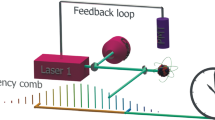Abstract
The roton excitation in the superfluid 4He does not possess a stationary dipole moment. However, a roton has an instantaneous dipole moment, such that at any given moment one can find it in the state either with positive or with negative dipole moment projection on its momentum direction. The instantaneous value of electric dipole moment of roton excitation is evaluated. The result is in reasonable agreement with recent experimental observation of the splitting of microwave resonance absorption line at roton frequency under external electric field.
Similar content being viewed by others
References
A. Rybalko, S. Rubets, E. Rudavskii, et al., Phys. Rev. B 76, 140503 (2007).
A. S. Rybalko, S. P. Rubets, E. Ya. Rudavskii, et al., Fiz. Nizk. Temp. 34, 326 (2008) [J. Low Temp. Phys. 34, 431 (2008)].
A. S. Rybalko, S. P. Rubets, E. Ya. Rudavskii, et al., arXiv:0811.2114.
The momentum compensation by the flow of superfluid component has been considered by A. S. Rybalko, S. P. Rubets, E. Ya. Rudavskii, et al., Fiz. Nizk. Temp. 35, 1073 (2009) [J. Low Temp. Phys. 35, 1177 (2009)]. We use here the same argumentation without reference to superfluid motion which loses its sense at frequencies much higher than temperature.
G. E. Volovik, Pis’ma Zh. Eksp. Teor. Fiz. 15, 116 (1972) [JETP Lett. 15, 81 (1972)].
Author is indebted to G. Volovik for this remark.
A. S. Rybalko, S. P. Rubets, E. Ya. Rudavskii, et al., arXiv:0807.4810.
R. P. Feynman and Michael Cohen, Phys. Rev. 102, 1189 (1956).
To the best of my knowledge still there is no a microscopic proof the Feynman ideas. On the other hand, it was shown that the quantum vortices and the phononroton excitations belong to the different branches of solutions of the Gross-Pitaevskii equation with nonlocal potential of very special form (see N. G. Berloff and P. H. Roberts, J. Phys. A: Math. Gen. 32, 5611 (1999)). However, the applicability of the Gross-Pitaevskii equation to the description of the collective excitations in superfluid He-4 at interatomic scale of distances is questionable.
L. D. Landau and E. M. Lifshitz, Quantum Mechanics (Butterworth-Heinemann, Oxford, 1997).
Author information
Authors and Affiliations
Additional information
The article is published in the original.
Rights and permissions
About this article
Cite this article
Mineev, V.P. Roton dipole moment. Jetp Lett. 90, 768–770 (2010). https://doi.org/10.1134/S0021364009240072
Received:
Accepted:
Published:
Issue Date:
DOI: https://doi.org/10.1134/S0021364009240072




